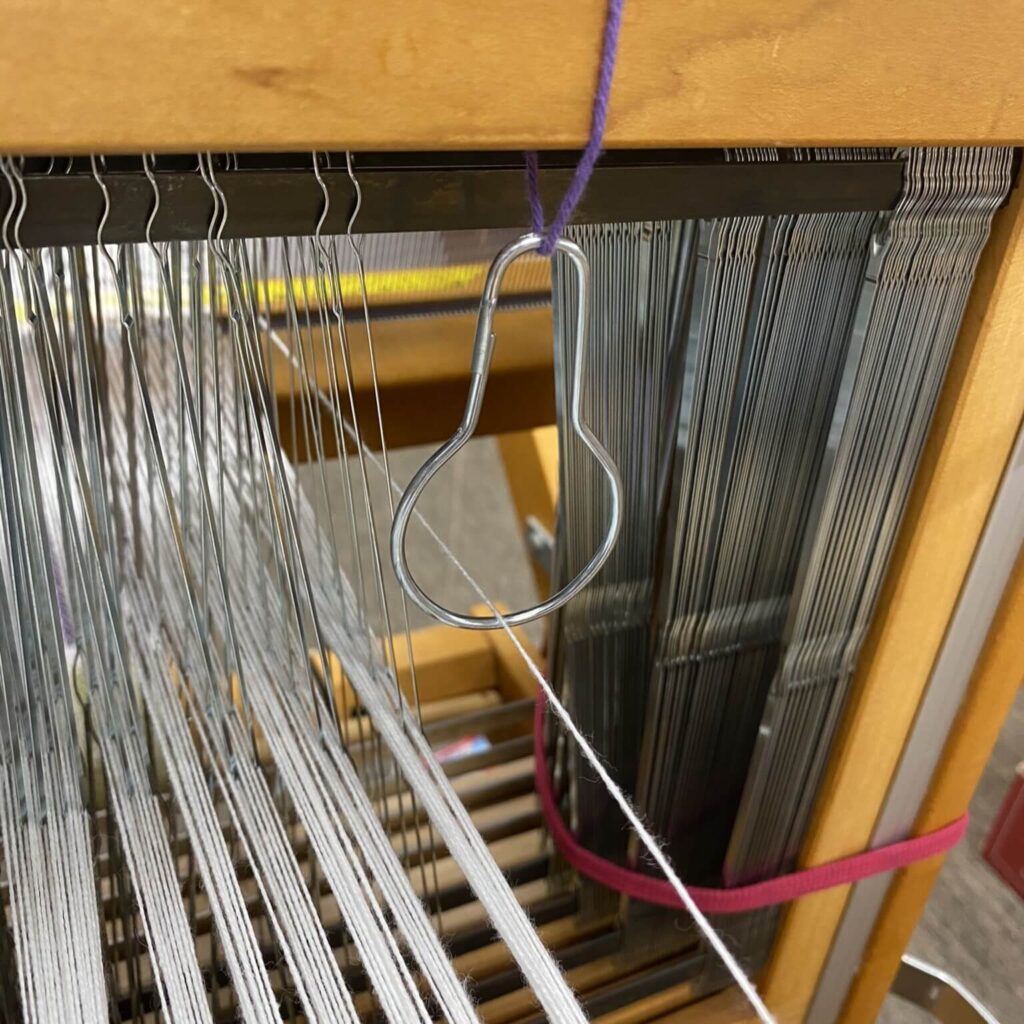I’m not a fan of floating selvedges. Moving their weights, separating them from the threaded ends they’re next to, lifting them up to go under or pushing them down to go over – that all detracts from my weaving experience. Anything that slows me down and interrupts my weaving zen irritates me every single time.
When I DO use floating selvedges, I want them to be as non-interactive as possible, so I don’t have to think about them any more than absolutely necessary.
In order not to detract from my weaving experience, floating selvedges need to
- Stay separate from their neighbours,
- Be easy to go over and under automatically with the shuttle, and
- Have weights that move automatically when I advance the warp.
Fortunately, this is pretty easy to achieve!
Keeping floats from clinging
A floating selvedge that’s sleyed into the same dent as its threaded neighbour has a tendency to catch on that neighbour when it goes up and down, which means the floating end may well go up and down right along with it. This doesn’t always happen – and happens less when there’s a bit of weight on the floating end – but when it does it’s super irritating. Putting a floating end into its own dent keeps that from happening.
Worried that sleying the floating end will affect the warp sett? Don’t be! Thanks to draw-in, the warp sett is usually a little closer at the edges anyway, so spacing out the floating selvedge won’t do anything untoward to your sett. The weft will pull that floating end right back up against the edge of the cloth anyway, no harm, no foul.
Adding some weight to the floating end will also help it stay disentangled from its neighbour, so it’s not a bad idea to hang even just one S hook or shower curtain ring from a float end even if it doesn’t seem to need it.
Lifting floats to make them easier to go under
Counterbalance and countermarch looms usually have nice, tall sheds, and floating ends stay right in the vertical center of the shed, making it easy to go over or under them with the shuttle.
On a rising shed jack loom, though, floating ends tend to ride very low, almost in the same plane as the bottom of the shed. It’s very easy to go over a float you should have gone under and, as a result, not encircle the floating end at all on a given pick. If you find your floating ends aren’t interlacing on every single pick, this is probably the cause.
To remedy this and make it much easier to go around them every time, all you need to do is lift up your floating selvedges so that they’re an inch or so above the bottom of the shed.
My preferred way to do this is by hanging shower curtain rings from the back of the castle that I can hook the floating ends into, like so:

The smooth metal of the rings lets the threads slide freely without friction that might cause wear. Once I get the shower curtain rings adjusted to the perfect height, they stay on my loom permanently, always available when I need them and never requiring any more fiddling.
You can also use an S hook for this purpose, but because an S hook isn’t a closed loop you need to watch out that the floating end doesn’t jump out of the hook and that other ends don’t jump in.
Weights that move automatically
As long as the floating ends are beamed with the rest of the warp, it’s easy to add a weight that will slide automatically when you advance the warp so that you never have to go to the back of the loom and move it yourself.
I use a shower curtain ring for this purpose, too. If I only need a smidge of weight, I simply hook the shower curtain ring onto the thread and let it hang below the warp beam. If I want more weight, I hang a washer or two (or ten!) from the shower curtain ring before I click it closed. The amount of weight is easy to adjust at any time.

When I advance my warp, gravity keeps the ring in place under the beam without me having to move it. If there’s less take-up on the floating end than on the other warp threads, it will hang lower and lower below the beam over time, but it will always apply the same amount of weight and therefore tension on the thread regardless.
Again, you can use an S hook for this purpose, but you need to watch out that it doesn’t jump off the floating end and stop providing weight and that it doesn’t hook around non-floating ends.
Weights that move easily and don’t spin
If your floating ends are not beamed with the warp things aren’t quite as simple, so the first question to ask is whether you really need to add a hanging end or if you can simply unthread the first and last warp end from their heddles and use them as floating selvages. Heck, if you’re willing to sacrifice the heddles, you could even cut the heddles off of the threads and turn them into floats without disconnecting them from the already woven cloth!
If you do wind up with floating ends that are not beamed with the warp, it’s important to make sure that they don’t spin as they dangle. If they spin, they’ll probably tangle on any other hanging threads, and may even unply and come apart.
To prevent a weighted hanging end from spinning, make sure it’s “grounded” by being in contact with the floor. The easiest way to do that is to put its stored length right on the floor, or attached to something sitting on the floor. I like to wind the length around a bobbin or cardboard core from an empty spool of yarn and drop that into a shuttle, but the outside of a film canister or pill bottle also works. I like the bobbin in a shuttle because it will unwind as needed to provide more length rather than me having to unwind it manually.
In order to apply tension, the weight on the floating ends needs to hang, which means it can’t be attached to the yarn supply if that supply is sitting on the floor. Instead, you need a way to hang weight from the length of thread that’s hanging between the back beam and floor.
If the thread is smooth, you can simply tie a slip knot in that hanging length and hang your weighted shower curtain ring from the loop that creates. The closer you can get the weight to the floor each time you move it, the less often you’ll have to move it.

If your thread is heavily textured and the weight required is heavy enough to pull the slip knot tight, it might not be easy to remove it again. In that case, you can make a lark’s head out of the hanging length of thread and put a shower curtain ring or S hook through that instead. In this case, an S hook might be better because the yarn will slide off of it more easily, but the lark’s head will keep it from sliding off until you want it to. Regardless, the lark’s head will come apart as soon as the ring or hook is removed without untying anything.

